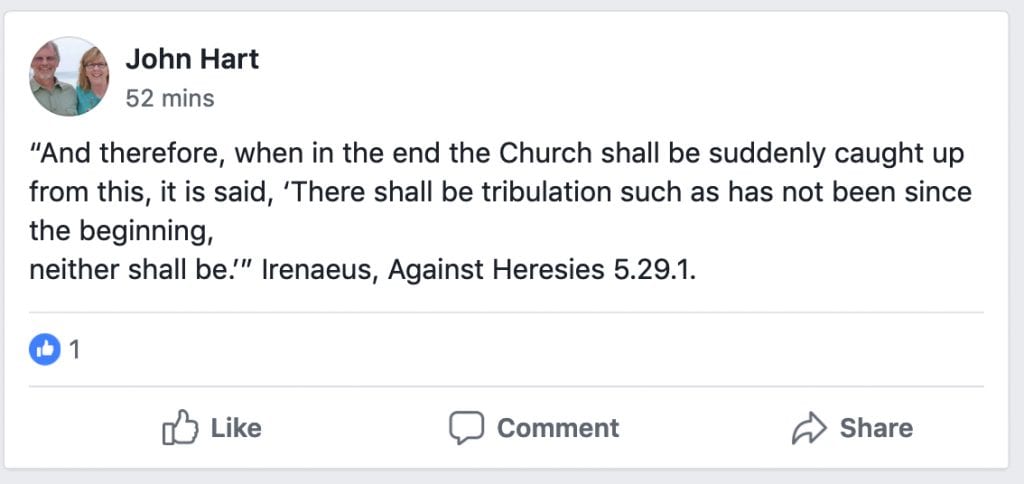Irenaeus Taught that the Church Would Face the Antichrist
I want to respond to pretribber John Hart’s misrepresentation of Irenaeus, taking a snippet of Irenaeus out of context and making it sound like he is teaching a pretrib rapture. Nothing could be further from the truth for three contextual reasons.
First
In Hart’s proof text, I noticed that he conveniently omits the very next statement, where Irenaeus states: “For this is the last contest of the righteous, in which, when they overcome they are crowned with incorruption” (5.29.1).
Irenaeus states that the church will be caught up “from this,” which he identifies as the great tribulation (cf. Matt 24:21, 31). So the question then is does “from this” mean from before it happens or from as it is happening? Pretribs assume without any evidence that it means before it happens. But the statement that Hart carelessly omits constrains the meaning, which identifies “from this” with the period of great tribulation that the righteous will experience: “For this is the last contest of the righteous, in which, when they overcome they are crowned with incorruption [resurrection].” Irenaeus is therefore linking “the last contest of the righteous” with the period of great tribulation.
This is confirmed by two other contextual factors in the same context.
Second
Staying in the context of Irenaeus’s statement, in the very next verse, he exhorts believers to persevere and be faithful during the wicked period of Antichrist, just as the remnant of the righteous persevered during the wicked period during Noah’s day and the trial of Nebuchadnezzar’s idolatrous period. Only after the time of Antichrist, “a cataclysm of fire shall also come [upon the earth].”
And there is therefore in this beast, when he comes, a recapitulation made of all sorts of iniquity and of every deceit, in order that all apostate power, flowing into and being shut up in him, may be sent into the furnace of fire. Fittingly, therefore, shall his name possess the number six hundred and sixty-six, since he sums up in his own person all the commixture of wickedness which took place previous to the deluge, due to the apostasy of the angels. For Noah was six hundred years old when the deluge came upon the earth, sweeping away the rebellious world, for the sake of that most infamous generation which lived in the times of Noah. And [Antichrist] also sums up every error of devised idols since the flood, together with the slaying of the prophets and the cutting off of the just. For that image which was set up by Nebuchadnezzar had indeed a height of sixty cubits, while the breadth was six cubits; on account of which Ananias, Azarias, and Misael, when they did not worship it, were cast into a furnace of fire, pointing out prophetically, by what happened to them, the wrath against the righteous which shall arise towards the [time of the] end. For that image, taken as a whole, was a prefiguring of this man’s coming, decreeing that he should undoubtedly himself alone be worshipped by all men. Thus, then, the six hundred years of Noah, in whose time the deluge occurred because of the apostasy, and the number of the cubits of the image for which these just men were sent into the fiery furnace, do indicate the number of the name of that man in whom is concentrated the whole apostasy of six thousand years, and unrighteousness, and wickedness, and false prophecy, and deception; for which things’ sake a cataclysm of fire shall also come [upon the earth]. Against Heresies, 5.29.2
That Irenaeus compares the events of Noah and Nebuchadnezzar with the period of the Antichrist in order to exhort believers to persevere makes no sense in a pretrib interpretation. Rather, it makes complete sense for Irenaeus to compare these two similar Old Testament periods of testing, because he believes the church is going to experience a similar testing period in the future when she faces the Antichrist’s great tribulation.
Third
If we broaden the contextual scope before and after Irenaeus’s statement, it will be seen that he clearly makes additional statements that the Church will encounter the Antichrist. The following relevant statements by Irenaeus are also selectively omitted from John Hart’s snippet.
And they [the ten kings who shall arise] shall lay Babylon waste, and burn her with fire, and shall give their kingdom to the beast, and put the Church to flight. (Against Heresies, V, 26, 1)
It is therefore more certain, and less hazardous, to await the fulfillment of the prophecy [the Antichrist], than to be making surmises, and casting about for any names that may present themselves, inasmuch as many names can be found possessing the number mentioned; and the same question will, after all, remain unsolved. . . . But he indicates the number of the name now, that when this man [the Antichrist] comes we may avoid him, being aware who he is. (Against Heresies, V, 30, 3, 4)
For all these and other words were unquestionably spoken in reference to the resurrection of the just, which takes place after the coming of Antichrist. . . . [A]nd [with respect to] those whom the Lord shall find in the flesh, awaiting Him from heaven, and who have suffered tribulation, as well as escaped the hands of the Wicked one. (Against Heresies, V, 35, 1)


Leave a Reply